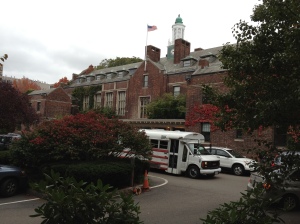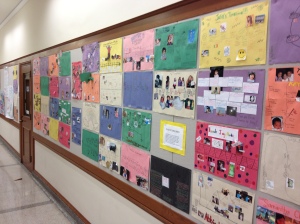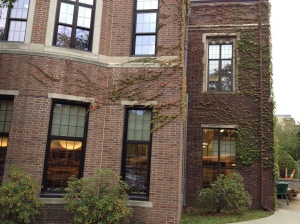We know that learning content for our students is generally easier than learning skills. The same holds true for adults. As we transform our ideas about how best to prepare our students for the world in which they will live, our teachers need to adapt to new ways of teaching. The “what” of new teaching methods is made easier if the “how” of transforming a learning organization, public or private, successful or struggling, is done well. Process is a critical part of any change. Schools that get the process right have a much better chance of successfully innovating than those that misread, misstep, or misunderstand. This post is all about process, so if you are on the arc of school innovation and want to share ideas, read on. If you know another school leader who maybe is unsure of how to create an effective innovation pathway, forward this link!
 According to Head Rachel Friis Stettler, The Winsor School is the only NAIS school in the city of Boston. They teach about 430 girls, grades 5-12. I was only able to spend a few hours there, but I did meet with a number of faculty who are involved in a highly intentional, multi-year process of transformation that I think others will find as enlightened as I did. (Apologies if I get any of the big steps out of sequence.)
According to Head Rachel Friis Stettler, The Winsor School is the only NAIS school in the city of Boston. They teach about 430 girls, grades 5-12. I was only able to spend a few hours there, but I did meet with a number of faculty who are involved in a highly intentional, multi-year process of transformation that I think others will find as enlightened as I did. (Apologies if I get any of the big steps out of sequence.)
Rachel and her leadership team started the process a number of years ago by creating opportunities and expectations for faculty and staff to learn more about educational innovation, (recognizing of course that much of what pundits were returning to within the last decade would have fit right in with Dewey et al from more than a century ago). Her vision when she came to Winsor nine years ago was to have a school that really thinks about the instructional practices of teaching and learning, not just outcomes. She wanted to take the time and energy to build the case for change with her faculty, to expose them to new ideas, allow them to increase their external connections, and establish an expectation of teaching as an evolving, not static, practice. She increased the PD budget and realigned existing money to focus on these priorities. She asked every member of her faculty to attend the Harvard Project Zero summer program in order to establish a common background and language. Time at faculty meetings became more focused on the discussion of how to implement 21C-type teaching styles.
As this learning process unfolded, the Winsor faculty took on other big discussions that would ultimately contribute to a re-statement of learning priorities. A faculty group studied the faculty evaluation, compensation, and workload profiles, and those underwent significant revision. Rachel created three faculty committees to undertake a one-year study of key questions: technology, global competencies, and skills and instruction. The committees each had about eight members, but every member of the faculty was affiliated with one of the committees. During the study phase every member of the faculty went out for external school visits, and brought ideas back to vet and share.
 They set up a key new group, the Teaching and Learning Committee, which is a critical part of their work and, I think, their success. The charge of the TLC is to investigate and bring to Winsor best innovative instructional practices, and to create mechanisms for these to be adopted by every member of the faculty. Participation in the TLC changes every year, with the goal that the number of thought leaders in the community increases all the time and those thoughts leaders can provide resources in support of the mission. The TLC provides a home and locus of responsibility for teaching and learning priorities, which is critical to a sustainable effort.
They set up a key new group, the Teaching and Learning Committee, which is a critical part of their work and, I think, their success. The charge of the TLC is to investigate and bring to Winsor best innovative instructional practices, and to create mechanisms for these to be adopted by every member of the faculty. Participation in the TLC changes every year, with the goal that the number of thought leaders in the community increases all the time and those thoughts leaders can provide resources in support of the mission. The TLC provides a home and locus of responsibility for teaching and learning priorities, which is critical to a sustainable effort.
AFTER all of this, it was time for a year of strategic planning. As we have discussed, strategic planning is often flawed if it happens out of sequence with the tackling of big discussions. Big discussions take time, as Rachel knew, and cannot be started and ended in a year, the normal time allotted for strategic planning. By engaging these discussions over a longer period, the strategic plan was able to use an enormous amount of thoughtful work product, and to synthesize a core set of institutional values to guide future work. Rachel gives credit to her board for not forcing the strategic plan before the big discussions were held, but to allow the process to unfold first.
According to English teacher and chair of the TLC, Indu Chugani, the strategic plan had two main academic foci:
- Faculty will use student-centered learning and formative assessment
- All teachers will include a suite of “21C” skills in their instruction.
Both Rachel and Indu said that by creating these strategic goals out of such a rich set of discussions, most of the faculty are on “the train”. Being off the train is not an option. The school continues to allocate resources to help faculty make the transitions they need to align with the strategic goals. As Rachel said, the train, the system of best instructional practices that is supported by the TLC, is a self-perpetuating commitment to a set of values. It is not about what each teacher teaches; it is about how they teach supports the key school values of learning.
 Going forward, the TLC is setting up and tracking several other efforts. They are piloting “instructional rounds” as some faculty reach out and try new practices, and can show them to others. The TLC is responsible for creating opportunities, and leaves assessment of how well the teachers are taking advantage of those opportunities to the department chairs and Associate Head. The school has also recognized (as so many others I have visited) that several other school policies and practices are not completely aligned with the core goals of the plan, including the daily schedule, grading practices, student assessments, and the quantity and type of course work. They will be tackling these in the future, but what I think is so important is that the tackling will be done within a framework of goals, and not each in a discussion on its own. In my view, they did the truly heavy lifting in those years running up to the strategic plan, by making and validating the case for what kind of change they wanted to implement. The rest is fitting the pieces together.
Going forward, the TLC is setting up and tracking several other efforts. They are piloting “instructional rounds” as some faculty reach out and try new practices, and can show them to others. The TLC is responsible for creating opportunities, and leaves assessment of how well the teachers are taking advantage of those opportunities to the department chairs and Associate Head. The school has also recognized (as so many others I have visited) that several other school policies and practices are not completely aligned with the core goals of the plan, including the daily schedule, grading practices, student assessments, and the quantity and type of course work. They will be tackling these in the future, but what I think is so important is that the tackling will be done within a framework of goals, and not each in a discussion on its own. In my view, they did the truly heavy lifting in those years running up to the strategic plan, by making and validating the case for what kind of change they wanted to implement. The rest is fitting the pieces together.
Is everyone on board the train? No. Do they need more time in the day to meet and collaborate to really validate and implement new teaching styles? Yes. Are they 100% sure that the teaching methods of today will be valid 5-10 years from now? Absolutely not. As Rachel said, “tradition is a way of avoiding best practices”, and that is going to hold true at any point in the future, not just today. John Dewey: “If we teach today as we taught yesterday, we rob our children of tomorrow”.




Grant, the posts this week seem even more superb to me. I remarked earlier that you have appeared to find a stride – perhaps the patterns and trends are coming more into focus as the data set enlarges and emerges.
I have a question. You write,
“According to English teacher and chair of the TLC, Indu Chugani, the strategic plan had two main academic foci:
Faculty will use student-centered learning and formative assessment
All teachers will include a suite of “21C” skills in their instruction.”
How then has the school developed the detailed architectural plans and engineering schema to make these large-scale, high-view “campus master plans” a reality? Does that question make sense?
Are any and all methods for including a suite of 21C skills accepted? How are formative assessment plans aligned with the varieties of methods used to create 21C skills instruction? How is this level of design work being accomplished?
Great questions and too much to answer in detail, and I would not be the best to do so. But in summary the TLC is developing those strategies to support and develop learning through PD, internal sharing, and others. They would not say they have it fully developed but they are solidly on the path. Indu could share more and would be a great presenter about what is working and how they are designing it.
Thanks, Grant.
[…] Rich,Thoughtful Process Bodes Well For Innovation at Winsor School, Boston October 10, 2012 […]